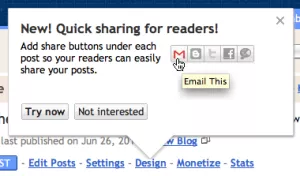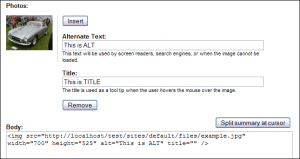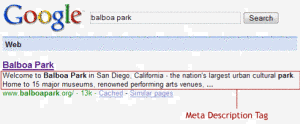15 Valuable and Practical SEO Tips For Bloggers
[caption id="" align="aligncenter" width="758"] So much depends upon your content, so make sure it's optimized. Via Growbo.com[/caption]
So much depends upon your content, so make sure it's optimized. Via Growbo.com[/caption]
Blogging is about quality content. Well-written, interesting will find an audience regardless of how many SEO tips are employed. However, there is a difference between finding an audience and finding a targeted audience that is likely to convert based on your blog content. These SEO tips will boost your blog's on search engines and encourage your readers to spend more time engaging with your blog.
1. Write For Your Audience
One of the simplest ways to optimize your blog posts is to focus on writing things that are relevant to your specific audience. If you are writing content that gives them the information that they seek, your SEO is going to improve. This is because your bounce rates will be lower, your visitors will spend more time on each page, they will watch your videos, and follow your links. This isn’t to say that you cannot write about trending topics or share viral content. Just be certain you always focus on your target audience.
2. Use Internal Links
Internal links are links within your blog posts that lead to other pages within your blog or website. The first and most obvious way that this improves SEO is that increases traffic to your other posts and pages. In addition to this, when placing an internal link in one of your blog posts, you have essentially told search engine spiders that the content that you have linked to is important. Remember that the most effective way to use internal links is to make sure that they are relevant to the content that you are writing.
3. Customize Your Robots.txt file
Your Robots.txt file is essentially a list of instructions for search engine spiders. For example, it tells search engines which pages of your blog to index for search and which to ignore. This stops search engine spiders from considering content that is not relevant to your audience when indexing your blog or website.
4. Make Your Share Buttons Easy to Find
When people share your content on their social media pages, a few different things happen. First, the inbound link boosts SEO. In addition to this, social shares lead to more visitors to your blog, and more conversation about your content. Ultimately, this can lead to new subscribers. Unfortunately, if you aren’t making it easy for visitors to share your content, you won’t reap any of these benefits. Be sure you are including share buttons on your blog posts, and that they are in a prominent Location.
5. Create Great Content
Not too many years ago, content quality really didn’t matter. As long as what you wrote was somewhat relevant and you used all of the right keywords (and lots of them!), you could get a pretty good SERP placement. Fortunately, that’s just not the case anymore. Your audience and search engines both have higher standards now. If you want your blogs to be optimized for SEO, you have to know how to produce outstanding content. This means writing content that is relevant, trending, well-written, and accurate. If you accomplish this, you will get the traffic and shares that will keep your rankings where you want.
6. Use The Google Webmaster Tool
The Google Webmaster Tool is a handy set of utilities that allows you to see your website or blog from Google’s perspective. If you use this tool, you can learn your average position on search engine results pages, which keywords your blog is ranked for, how many people are clicking on your blog from search engine results pages, and changes to these metrics that have occurred over time. You can also drill down into specific keywords to get more information. You can use all of this information to get an idea of what is working for you as far as using keywords, meta tags, and overall SEO strategy.
7. Earn Backlinks
Backlinks are links to your content from other websites, social media posts, and blogs. They are extremely important for SEO as they are, in essence, a vote of confidence in your content. Just as this counts in your favor when you link to your content internally, backlinks also count in your favor. However, backlinks carry far more weight than internal links. In addition to this, if an influential person links to your content, you are essentially getting that person’s endorsement. Backlinks also boost traffic to your blog through direct clicks.
There are ways to pay for backlinks, but they aren’t very effective. The best way to get others to link to your content is to participate in your online community. This means following and friending people and businesses in your niche, linking to their content, commenting on their posts, and doing other things that help you to build relationships. Promoting your blog content on your social media pages is another effective technique to get people to look at and share your content with others.
8. Optimize Your Images
Hopefully, you are including images in your posts (more on that later). However, if you are including images, you are aren’t getting the full SEO boost that you can, if you aren’t optimizing those images. You can start optimizing your images by using relevant ALT tags. Since search engines cannot truly ‘see’ and image. Your ALT tags tell them what is in your images. The names of your image files matter as well. Don’t name a file Image_1_AX235.JPG. That doesn’t mean anything. Instead, your file name should indicate what your image is in as much detail as can fit. For example, BALOON.JPG is good, but Red_Baloon_With_Happy_Face.JPG is even better. You should also take advantage of the long description attribute to give full detail. You will also want to optimize the size of your image so that it takes up as little space as possible while still maintaining size and quality. Finally, if it makes sense to do so, use keywords in your captions.
9. Use Title Tags to Your Advantage
In order to let Google and other search engines know what an individual post is about, use well-written title tags. This is why it is extremely important to include in title tag on your posts. There are, however, some steps you should take to optimize these tags. First, keep these tags to 70 characters or less for display purposes. Then, remember to begin your tags with your most important keywords. You want your title tag to make sense and to flow as a sentence, or fragment of a sentence, but you do not want to waste a lot of space on prepositions, articles, or pronouns.
10. Be Smart About Your Keywords
In spite of changes that Google has rolled out over the past couple of years, using keywords is one of the best SEO tricks there is. You just have to use them in the right way. First, every keyword phrase that you use should be relevant and grammatically correct. Don’t use keywords simply because they are trending. Next, spread your keywords out in your posts. Finally, use keywords in and around links, in titles, and in subtitles.
11. Don’t Encourage Bouncing
Bouncing is when somebody clicks into your blog and then clicks back out without taking the time to read your content, click any links, or answer your call to action. Every page is going to have some bounces. Somebody may inadvertently click your link, or they may genuinely misunderstand what your content is about and leave without taking action. Unfortunately, if your bounce rate is too high, that negatively impacts SEO. In order to prevent too many bounces, be sure to clean up the following issues:
- Video or audio that begins playing without the visitor’s consent
- Content that doesn’t match search engine results
- Failure to optimize for mobile
- Obnoxious fonts and backgrounds
- Too much space dedicated to ads and links
12. Write For Other People - But be Selective
A few good things happen when you write for other people. First, if you guest blog for people in your industry, you have the chance to get their audience interested in your content. The same thing happens if you write articles for relevant publications. In addition to this, most bloggers and websites will allow you to include biographical information along with a link to your blog or website if you write for them. Some may even okay you linking to your content in the posts you write for them as long as it is relevant, and your content is well-written.
If you are going to write for other people, it is very important to be selective. Writing for article directories, or for websites that take any article on any subject won’t do you very much good. The individual articles posted at these sites rarely get any traction. It’s also not going to give you any kind of boost in reputation as a blogger to announce that you’ve written for websites that aren’t selective at all.
13. Write Catchy Meta Descriptions
The meta description is what appears as the description of a blog post in search engine results. This is the text that people will use to determine whether or not your post contains the information they are looking for. Good meta descriptions include a call to action along with a short description of what the visitor will see when they click on your page. Your meta description should tell surfers what is in your post, and why it is beneficial for them to click. Ideally, your meta description will contain a keyword or two. Just keep it less than 155 characters, and make sure your meta description matches your content.
14. Include Links to Relevant External Sites
When you link to reputable 3rd parties in your website, you are indirectly benefitting your SEO in many ways. First of all, when 3rd parties find that you have linked to their content, they are much more likely to share that content with their followers. In addition to this, they may also provide you with a reciprocal inbound link. Providing outbound links also gives your readers access to expertise that they may need, but that you do not have to give to them.
15. Use Images, Interactive Content and Videos
If you use images, videos, infographics, interactive content and other alternatives to solely text-based content, you increase the chance that people will read and share your posts. Visual content also improves SEO, as long as you follow some of the best practices mentioned earlier.
And what you would like to add? Please leave a comment below.


















